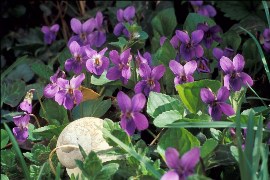Classification
How it fits in with the rest of the group
Viola odorata is a Latin scientific name for The Sweet Violet. In English, Viola odorata means a widely naturalized European violet typically having purple or white flowers.
o They are multicellular
organisms with membrane bound
organelles.
Kingdom – Plantae
o
They are autotrophic
which means they have
chlorophyll.
They are also photosynthetic and have cell walls made of cellulose.
Subkingdom
– Tracheobionta
o
They have vascular tissues and also undergo
alternation
of generations with dominant sporophyte.
Superdivision
– Spermatophyta
o
They have
seeds.
Phylum
– Anthophyta
o
They undergo
double fertilization.
Class
– Magnoliopsida
o
They are dicots
meaning they have two cotyledons.
The flower parts are in four or fives and leaf venation is usually netlike.
Subclass
– Dilleniidae
o
Their stamens,
when numerous, are initiated in centrifugal
sequence.
Order
– Violales
o
They have a uniocular, compound
ovary with mostly
parietal
placentation.
Family
– Violaceae
o
The flowers are asymmetrical, having five separate
sepals, five separate petals, five
stamens that usually have the filaments fused
in a ring around the ovary, and a three
celled compound pistil with a superior
ovary.
Genus
– Viola
L.
o
They have large,
hairy, heart-shaped leaves.
Species
– Viola odorata
o
The
flowers have a sweet scent.

Phylogenetic Tree
Phylo


